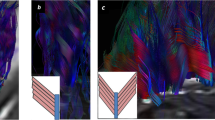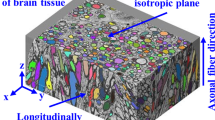Abstract
The combination of finite-element models with medical imaging has been a valuable contribution to our understanding of tissue mechanics. In recent years, diffusion tensor imaging has aided in modeling axonal tracts in the brain to measure mechanical stresses related to traumatic brain injuries. Other biological systems and diagnostic techniques can benefit from this approach. Dynamic elastography is a phase contrast imaging technique, where contrast is linked to the mechanical properties (elasticity and viscosity) of the imaged tissue. Mechanical properties are obtained from solving an inverse system based on mechanical wave motion, typically under the assumption that the tissue is homogeneous, isotropic and without initial (pre) stresses or strains. Biological tissues, however, rarely have all three of these properties and the degree to which these assumptions are inaccurate can lead to poor estimates. Muscle typically violates all three major assumptions and requires more refined approaches for elastic moduli estimation. using magnetic resonance-based diffusion tensor (DT) imaging to inform the generation of subject-specific finite-element (FE) models addresses this problem by explicitly accommodating for variations in muscle architecture. This allows for a more robust analysis of prestressed wave motion while compensating for situational geometric changes induced by the loading. The presented work demonstrates a pipeline from DT imaging to FE models and the resulting comparisons with analogous MR elastography experiments. This work will help in developing anisotropic and prestressed relevant inversion algorithms, therefore, improving the accuracy of muscle elastic and viscous moduli estimates.












Similar content being viewed by others
References
Salameh N, Larrat B, Abarca-Quinones J, Pallu S, Dorvillius M, Leclercq I, Fink M, Sinkus R, Van Beers BE (2009) Early detection of steatohepatitis in fatty rat liver by using MR elastography. Radiology 253:90–97. https://doi.org/10.1148/radiol.2523081817
Canu E et al (2011) Mapping the structural brain changes in Alzheimer’s disease: the independent contribution of two imaging modalities. J Alzheimers Dis 26:263–274. https://doi.org/10.3233/JAD-2011-0040
Sack I, Jöhrens K, Würfel J, Braun J (2013) Structure-sensitive elastography: on the viscoelastic powerlaw behavior of in vivo human tissue in health and disease. Soft Matter 9:5672. https://doi.org/10.1039/c3sm50552a
Qin EC, Jugé L, Lambert SA, Paradis V, Sinkus R, Bilston LE (2014) In vivo anisotropic mechanical properties of dystrophic skeletal muscles measured by anisotropic MR elastographic imaging: the mdx mouse model of muscular dystrophy. Radiology 273:726–735. https://doi.org/10.1148/radiol.14132661
Wuerfel J et al (2010) MR-elastography reveals degradation of tissue integrity in multiple sclerosis. Neuroimage 49:2520–2525. https://doi.org/10.1016/j.neuroimage.2009.06.018
Guimarães CF, Gasperini L, Marques AP, Reis RL (2020) The stiffness of living tissues and its implications for tissue engineering. Nat Rev Mater 5:351–370. https://doi.org/10.1038/s41578-019-0169-1
Tweten DJ, Okamoto RJ, Bayly PV (2017) Requirements for accurate estimation of anisotropic material parameters by magnetic resonance elastography: a computational study: accurate estimation of anisotropic material parameters by MRE. Magn Reson Med 78:2360–2372. https://doi.org/10.1002/mrm.26600
Schmidt JL, Tweten DJ, Benegal AN, Walker CH, Portnoi TE, Okamoto RJ, Garbow JR, Bayly PV (2016) Magnetic resonance elastography of slow and fast shear waves illuminates differences in shear and tensile moduli in anisotropic tissue. J Biomech 49:1042–1049. https://doi.org/10.1016/j.jbiomech.2016.02.018
Kalra P, Raterman B, Mo X, Kolipaka A (2019) Magnetic resonance elastography of brain: comparison between anisotropic and isotropic stiffness and its correlation to age. Magn Reson Med 82:671–679. https://doi.org/10.1002/mrm.27757
Guertler CA, Okamoto RJ, Ireland JA, Pacia CP, Garbow JR, Chen H, Phillip PV (2020) Estimation of anisotropic material properties of soft tissue by MRI of ultrasound-induced shear waves. J Biomech Eng 142:031001. https://doi.org/10.1115/1.4046127
Shams M, Destrade M, Ogden RW (2011) Initial stresses in elastic solids: constitutive laws and acoustoelasticity. Wave Motion 48:552–567. https://doi.org/10.1016/j.wavemoti.2011.04.004
Crutison J, Sun M, Royston TJ (2022) The combined importance of finite dimensions, anisotropy, and pre-stress in acoustoelastography. J Acoust Soc Am 151:2403–2413. https://doi.org/10.1121/10.0010110
Strategic plan, Radiological Society of North America. https://www.rsna.org/about/reports/strategic-plan. (Accessed Mar 02, 2022)
Abramson RG et al (2015) Methods and challenges in quantitative imaging biomarker development. Acad Radiol 22:25–32. https://doi.org/10.1016/j.acra.2014.09.001
Chatelin S, Deck C, Willinger R (2013) An anisotropic viscous hyperelastic constitutive law for brain material finite-element modeling. J Biorheol 27:26–37. https://doi.org/10.1007/s12573-012-0055-6
Green MA, Geng G, Qin E, Sinkus R, Gandevia SC, Bilston LE (2013) Measuring anisotropic muscle stiffness properties using elastography. NMR Biomed 26:1387–1394. https://doi.org/10.1002/nbm.2964
Guidetti M, Royston TJ (2019) Anisotropic composite material phantom to improve skeletal muscle characterization using magnetic resonance elastography. J Mech Behav Biomed Mater 89:199–208. https://doi.org/10.1016/j.jmbbm.2018.09.032
Gennisson J-L, Grenier N, Combe C, Tanter M (2012) Supersonic shear wave elastography of in vivo pig kidney: influence of blood pressure, urinary pressure and tissue anisotropy. Ultrasound Med Biol 38:1559–1567. https://doi.org/10.1016/j.ultrasmedbio.2012.04.013
Wick C, Böl M, Müller F, Blickhan R, Siebert T (2018) Packing of muscles in the rabbit shank influences three-dimensional architecture of M. soleus. J Mech Behav Biomed Mater 83:20–27. https://doi.org/10.1016/j.jmbbm.2018.04.006
Kumar A, Khan NM, Anikhindi SA, Sharma P, Bansal N, Singla V, Arora A (2017) Correlation of transient elastography with hepatic venous pressure gradient in patients with cirrhotic portal hypertension: a study of 326 patients from India. World J Gastroenterol 23:687. https://doi.org/10.3748/wjg.v23.i4.687
Ryou M, Stylopoulos N, Baffy G (2020) Nonalcoholic fatty liver disease and portal hypertension. Explor Med 1:149–169. https://doi.org/10.37349/emed.2020.00011
Brinker S, Klatt D (2016) Demonstration of concurrent tensile testing and magnetic resonance elastography. J Mech Behav Biomed Mater 63:232–243. https://doi.org/10.1016/j.jmbbm.2016.06.020
Blemker SS, Pinsky PM, Delp SL (2005) A 3D model of muscle reveals the causes of nonuniform strains in the biceps brachii. J Biomech 38:657–665. https://doi.org/10.1016/j.jbiomech.2004.04.009
Sahoo D, Deck C, Willinger R (2016) Brain injury tolerance limit based on computation of axonal strain. Accid Anal Prev 92:53–70. https://doi.org/10.1016/j.aap.2016.03.013
Colgan NC, Gilchrist MD, Curran KM (2010) Applying DTI white matter orientations to finite element head models to examine diffuse TBI under high rotational accelerations. Prog Biophys Mol Biol 103:304–309. https://doi.org/10.1016/j.pbiomolbio.2010.09.008
Stadelmann MA, Maquer G, Voumard B, Grant A, Hackney DB (2018) Integrating MRI-based geometry, composition and fiber architecture in a finite element model of the human intervertebral disc. J Mech Behav Biomed Mater 85:37–42. https://doi.org/10.1016/j.jmbbm.2018.05.005
Manduca A, Bayly PJ, Ehman RL, Kolipaka A, Royston TJ, Sack I, Sinkus R, VanBeers BE (2020) MR elastography: principles, guidelines, and terminology. Magn Reson Med. https://doi.org/10.1002/mrm.28627
Bolsterlee B, Finni T, D’Souza A, Eguchi J, Clarke EC, Herbert RD (2018) Three-dimensional architecture of the whole human soleus muscle in vivo. PeerJ 6:e4610. https://doi.org/10.7717/peerj.4610
Yushkevich PA, Piven J, Hazlett HC, Smith RG, Ho S, Gee JC, Gerig G (2006) User-guided 3D active contour segmentation of anatomical structures: significantly improved efficiency and reliability. Neuroimage 31:1116–1128. https://doi.org/10.1016/j.neuroimage.2006.01.015
Clark JJ (1989) Authenticating edges produced by zero-crossing algorithms. IEEE Trans Pattern Anal Mach Intell 11:43–57. https://doi.org/10.1109/34.23112
Wallis SA, Georgeson MA (2009) Mach edges: local features predicted by 3rd derivative spatial filtering. Vision Res 49:1886–1893. https://doi.org/10.1016/j.visres.2009.04.026
Akleman E and Chen J (2005) Regular meshes. In: Proceedings of the 2005 ACM symposium on Solid and physical modeling - SPM ’05, pp 213–219. https://doi.org/10.1145/1060244.1060268
Grant JA (1970) Chebyshev polynomials in numerical analysis. Math Gaz 54:96–97. https://doi.org/10.2307/3613223
Yeh F-C, Verstynen TD, Wang Y, Fernández-Miranda JC, Tseng W-YI (2013) Deterministic diffusion fiber tracking improved by quantitative anisotropy. PLoS One 8:e80713. https://doi.org/10.1371/journal.pone.0080713
Hormann K, Agathos A (2001) The point in polygon problem for arbitrary polygons. Comput Geom 20:131–144. https://doi.org/10.1016/S0925-7721(01)00012-8
Lorensen WE and Cline HE (1987) Marching cubes: a high resolution 3D surface construction algorithm. In: SIGGRAPH ’87: Proceedings of the 14th annual conference on Computer graphics and interactive techniques, 7. https://doi.org/10.1145/37401.37422
Yasar TK, Royston TJ, Magin RL (2013) Wideband MR elastography for viscoelasticity model identification. Magn Reson Med 70:479–489. https://doi.org/10.1002/mrm.24495
Klatt D, Yasar TK, Royston TJ, Magin RL (2013) Sample interval modulation for the simultaneous acquisition of displacement vector data in magnetic resonance elastography: theory and application. Phys Med Biol 58:8663–8675. https://doi.org/10.1088/0031-9155/58/24/8663
Walimbe VS, Zagrodsky V, Raja S, Bybel B, Kanvinde M, Shekhar R (2004) Elastic registration of 3D whole body CT and PET images by quaternion-based interpolation of multiple piecewise linear rigid-body registrations. Med Imaging 5370:119. https://doi.org/10.1117/12.535501
Hill DLG, Batchelor PG, Holden M, Hawkes DJ (2018) Medical image registration. Phys Med Biol. https://doi.org/10.1088/0031-9155/46/3/201
Fovargue D, Kozerke S, Sinkus R, Nordsletten D (2018) Robust MR elastography stiffness quantification using a localized divergence free finite element reconstruction. Med Image Anal 44:126–142. https://doi.org/10.1016/j.media.2017.12.005
Papazoglou S, Hirsch S, Braun J, Sack I (2012) Multifrequency inversion in magnetic resonance elastography. Phys Med Biol 57:2329–2346. https://doi.org/10.1088/0031-9155/57/8/2329
Acknowledgements
The authors acknowledge funding from NSF, USA Grant No. 1852691 and NIH, USA Grant No. AR071162.
Funding
The authors acknowledge funding from NSF, USA Grant No. 1852691 and NIH, USA Grant No. AR071162.
Author information
Authors and Affiliations
Corresponding author
Ethics declarations
Conflict of interest
The authors have no other competing interests directly or indirectly relating to this manuscript.
Additional information
Publisher's Note
Springer Nature remains neutral with regard to jurisdictional claims in published maps and institutional affiliations.
Supplementary Information
Below is the link to the electronic supplementary material.
Rights and permissions
About this article
Cite this article
Crutison, J., Royston, T. The design and application of a diffusion tensor informed finite-element model for exploration of uniaxially prestressed muscle architecture in magnetic resonance imaging. Engineering with Computers 38, 3893–3908 (2022). https://doi.org/10.1007/s00366-022-01690-x
Received:
Accepted:
Published:
Issue Date:
DOI: https://doi.org/10.1007/s00366-022-01690-x




